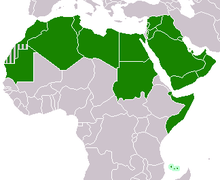Cinema of Tunisia
| Cinema of Tunisia | |
|---|---|
 Naceur Ktari (2000) | |
| Number of screens | 18 (2009)[1] |
| • Per capita | 0.2 per 100,000 (2009)[1] |
| Produced feature films (2005-2009)[2] | |
| Total | 4 (average) |
| Number of admissions (2008)[3] | |
| Total | 600,000 |
The cinema of Tunisia has been present since 1896, when the Lumière brothers began showing animated films in the streets of Tunis.
History
In 1919, the first feature-length movie produced on the North African continent: Les Cinq gentlemen maudits (The Five Accursed Gentlemen) was filmed in Tunisia. In 1924, Samama-Chikli directed a medium-length film called Ain Al-Ghazal (The Girl from Carthage) thus making him, one of the very first native filmmakers on the North African continent.[4] In 1966, the first feature Tunisian film (95 minutes) Al-Fajr (The Dawn) was directed and produced by Omar Khlifi; it was shot on a 35 mm film.[5] Tunisia also hosts the Carthage Film Festival which has been taking place since 1966. The festival gives priority to films from Arab and African countries. It is the oldest film festival on the African continent and the Arab World.[6]
In 1927, the first Tunisian film distribution company, Tunis-Film, started its activities. After independence, movies were exclusively produced by Société Anonyme Tunisienne de Production et d'Expansion Cinématographique (SATPEC) which controlled cinema and filming productions in the country at the time. Nevertheless, during the 1980s, private production companies and studios emerged and wanted to make Tunisia the Mediterranean Hollywood. The producer Tarak Ben Ammar, a nephew of Wasila Bourguiba, succeeded in attracting some big production companies to shoot inside his studios in Monastir. Major foreign movies were filmed in Tunisia including Roman Polanski's Pirates and Franco Zeffirelli's Jesus of Nazareth. After visiting Tunisia George Lucas was seduced by the natural beauty and authentic old architecture of some Southern Tunisian towns where he decided to film important scenes of Star Wars, as well as Indiana Jones. Moreover, Anthony Minghella filmed the nine Academy Awards winner The English Patient in a south-west oasis of the country.
When it comes to domestic productions, they were rare: the few movies which were produced since 1967 tried to reflect the new social dynamics, development, identity research and modernity shock.[7] Some of them achieved a relative success outside Tunisia such as La Goulette (Halq El-Wadi 1996) directed by Ferid Boughedir which showed a flashback of typical community life in the small suburb of La Goulette in a period where Muslims, Jews and Christians lived together in tolerance and peace. Halfaouine: Child of the Terraces (Asfour Stah 1990), from the same director Boughdir is possibly the biggest popular success in the history of Tunisian Cinema. The movie showed the life of a child from Tunis (Halfouine suburb) in the 60s who was on a quest to understand relationships, the world of women and how to be a man. In another earlier movie entitled Man of Ashes (Rih Essedd 1986) Boughdir was as always depicting Tunisian society without fear or favour and talked about prostitution, paedophilia and inter-faith relations between Tunisian Muslims and Tunisian Jews. In the 1991's film Bezness, he talked about the emerging sexual tourism inside the country. The Ambassadors (As-Soufraa 1975) directed by Naceur Ktari portrayed the life of immigrant Maghrebins in France and their struggle against racism. The film won the Golden Tanit for the best picture during the Carthage Film Festival in 1976, the special jury award from the Locarno International Film Festival in the same year and it has been classified in the Un Certain Regard category during the 1978 Cannes Film Festival.
The first Tunisian actress was Haydée Chikly, who starred in the short film, Zohra in 1922. The first feature film to be directed by a woman was Fatma 75 (1975) by Selma Baccar. Subsequent female directors films such as Néjia Ben Mabrouk's Sama (1988) and Moufida Tlatli's The Silences of Palace (1994).[8]
In 2007, several films were produced and grabbed public attention such as Making Of directed by Nouri Bouzid and Nejib Belkadi's VHS Kahloucha.
In 2013, Abdellatif Kechiche was the first-ever Tunisian director to win the Palme D'Or award. For his film Blue Is the Warmest Color he split the award with his two lead actresses.
Academy Award nominations
Tunisia has submitted films for the Academy Award for Best Foreign Language Film on an irregular basis since 1995. The award is handed out annually by the United States Academy of Motion Picture Arts and Sciences to a feature-length motion picture produced outside the United States that contains primarily non-English dialogue.[9] As of 2009, only two Tunisian films have been submitted for the Academy Award for Best Foreign Language Film and neither was nominated for an Oscar.
See also
References
- 1 2 "Table 8: Cinema Infrastructure - Capacity". UNESCO Institute for Statistics. Retrieved 5 November 2013.
- ↑ "Average national film production". UNESCO Institute for Statistics. Retrieved 5 November 2013.
- ↑ "Table 11: Exhibition - Admissions & Gross Box Office (GBO)". UNESCO Institute for Statistics. Retrieved 5 November 2013.
- ↑ History of Tunisian Cinema
- ↑ (French) AfriCiné profile of Omar Khlifi
- ↑ Carthage Film Festival Page on IMDB
- ↑ (French) Un cinéma dynamique (Tangka Guide)
- ↑ Chikhaoui, Tahar (May 1994). "Selma, Nejia, Moufida and the others". Ecrans d'Afrique (8): 10.
- ↑ "Special Rules for the Best Foreign Language Film Award". Academy of Motion Picture Arts and Sciences. Archived from the original on August 20, 2008. Retrieved 2009-09-06.
Further reading
- Robert Lang, New Tunisian Cinema: Allegories of Resistance, Columbia University Press, 2014, ISBN 978-0-231-16507-5
- Florence Martin, "Cinema and State in Tunisia" in: Josef Gugler (ed.) Film in the Middle East and North Africa: Creative Dissidence, University of Texas Press and American University in Cairo Press, 2011, ISBN 978-0-292-72327-6, ISBN 978-9-774-16424-8, pp 271-283

